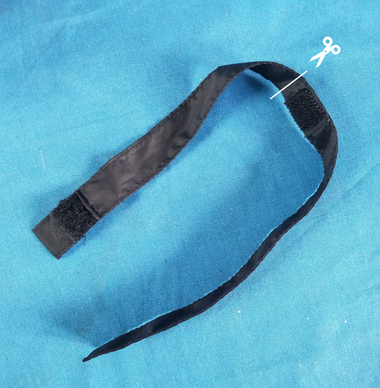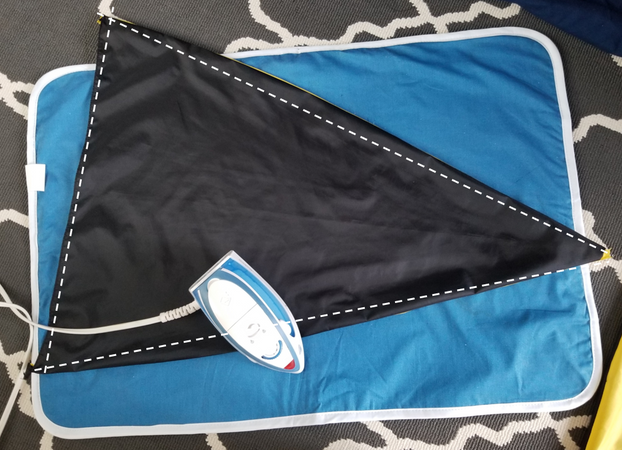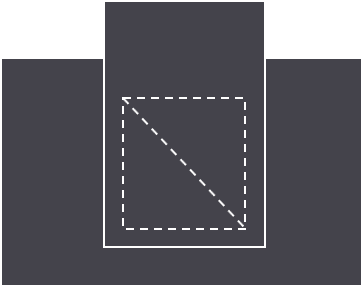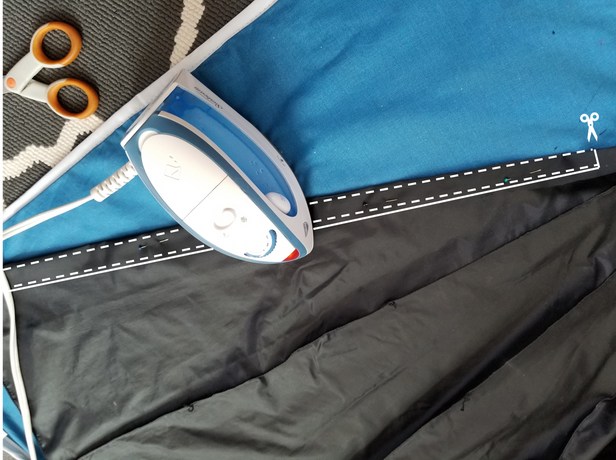How to make an umbrella apron
- Katie Rowe

- Jul 12, 2020
- 5 min read
Updated: Jul 14, 2020
When I started brainstorming things to make out of the umbrella fabric I'd collected, it didn't take long to add aprons to the list. That's partially because I just like them, at least in their modern form. Aprons make me think of the buzzing creative energy of a workshop or studio, or the type of cooking that requires a little extra planning. You need an apron for a job worth doing.
I also thought the triangular shape of the umbrellas would be well suited to the apron form, and that there would be utility in the hydrophobic properties of polyester. Both have proved true! I ran spill tests with everything from water to spaghetti sauce and they are very wipe-able, although I can't make any promises for oils or paints.
The project shown in the photos is one of two aprons I made out of this $16.99 umbrella manufactured by Storm Duds and sold by the University of Maryland Baltimore Country bookstore (product photo is theirs). I picked it up on the sidewalk in the Manhattan with a couple of snapped pieces.
You'll need:
A sewing machine and machine thread (although you could also do this by hand)
4 triangular fabric panels from a large umbrella
The Velcro strap from an umbrella
Some additional material for making the straps. I used a thinner panel from a different umbrella, but you could also use one of the remaining panels from the main umbrella.
Preparing the body of the apron
Step 1: Remove the fabric from the umbrella frame and clean it (I will probably do a separate post about the preparation process at some point - I usually just soak the fabric in hot soapy water and try to scrub out any stains as best I can). Then separate the panels you want to use from the rest of the umbrella by ripping out the seams. You want an A/B pair for the top of the apron and another A/B pair for the skirt, and you can leave the pairs sewn together, Bonus: Be really careful with your seam ripping and save the thread for other projects!

Step 2: Pick your good sides and plan the general style and proportions of your apron. I had originally planned to use the yellow sides as the front. However, there was a major stain in the middle of one of them, so I decided to go with this double-layered bodice style instead to cover it up.

Step 3: Iron! Your fabric is probably pretty wrinkled, especially if you have washed and dried it. Remember that umbrellas are plastic: start on a very low heat setting and test a small section or piece of scrap first to make sure you aren't melting it.

Preparing the neck strap
Step 4: Remove the Velcro strap from the umbrella. On an umbrella strap, both sides of the Velcro are typically on one strap so it can wrap around itself to secure the umbrella it its closed position. However, we want them on separate straps so they can close behind your neck.
Step 5: You want the total length of both straps to be 18-24" long. It doesn't really matter how this length is distributed between the two, as long as the shorter strap is at least 3" long. The strap from your umbrella probably isn't long enough on its own, so you can supplement it with a piece of fabric from elsewhere on the umbrella or from your scrap pile. Just fold the fabric over so it is the approximate width of your existing straps, sew both sides, and then sew onto one of your straps.
Making the top half of the apron
Step 6: Fold the two fabric panels together with the "good side" of the fabric facing in, and sew the open long edge. If you didn't start with two connected pieces, sew both long edges. Try to follow the line of the original seam.
Step 7: Flip this triangle inside-out so that the good sides of the fabric are facing out. Press the seams, and add an edge stitch around all three sides. It doesn't need to be perfectly straight - again, just follow the seam.
Step 8: Fold the point of the triangle down and the sides in to form the apron top. The exact proportions of this are up to personal preference. I left a wide yellow stripe on either side of the fold. Pin down the sides but not the front panel.

Step 9: Attach the neck straps to the apron top, below the folded over front panel so the seams won't show through to the front. You should test this out after pinning it to make sure the proportions seem comfortable to you. I attach mine about half an inch down from the fold and ~6" apart from each other on center. Another nice touch is to make sure the softer part of the Velcro will face inward, because it's a little more comfortable for the wearer.
Step 10: Fold the top corners down and finish pinning together the apron top. Then, sew it all together.
Making the bottom half of the apron
Step 11: Cut the second A/B pair of triangle panels at about the halfway point vertically. This piece can be slightly taller or shorter depending on your preference, but halfway is a good starting point. Note that the skirt will be a few inches shorter that what you cut here after folding down a channel for the waist strap.

Step 12: Put the triangular piece aside for now and sew an edge seam around the two sides and bottom of the pentagonal piece.

Step 13: Create a channel for the waist strap by folding down about 1.5" from the top. I also fold the raw edge under before pinning so that it doesn't show. I sew the bottom seam of the channel first, and then pin the full bottom half of the apron to the top half so that the seam at the top of the strap channel will also secure the two halves together.
Step 14: Use the triangular piece that you trimmed off of the apron skirt to make a pocket. Fold the triangle in half vertically again and trim off the triangle. Then, fold the raw edge on the wider end of the pentagon over twice and sew to hem it. This will be the open end of the pocket. Finally, attach the pocket to the apron skirt, folding in any raw edges or unwanted corners.
Step 15: Attach the apron bottom to the top piece by sewing along the top edge of the channel.

Making the waist strap
Note: This requires an additional piece of material, either from your umbrella or something else. You really just need something to tie behind your waist here - you could also use a piece of ribbon or rope you have lying around. I have a stash of long thin umbrella panels which I reserve for this purpose, so that's what I've used here.
Step 16: Fold over about an inch of material and sew along both edges. Then cut the strap out of the material and repeat. The strap on this one is 53" long, but go for 60" or more if you can.
Step 17: Put it all together. I find it easiest to thread one section of strap through the channel and then sew the other strap pieces to the ends of the first, but you could also finish the strap first and then thread it in. It's also nice to add a finishing seam to the ends of the straps.

Step 18: Get cooking! Or painting or building or baking or designing or making...















































Comments